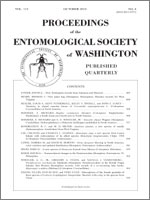Orius diespeter Herring was described in 1966 based on two specimens collected in western British Columbia, Canada. The original description relied mainly on color of the hemelytra to distinguish this species from Orius tristicolor (White), a related species common in western North America. Orius diespeter is shown here to have variation in color; hemelytra coloration ranges from entirely dark, to dark with contrasting white on the basal half of the corium. Specimens of O. diespeter with white markings are easily confused with O. tristicolor. Orius diespeter is separated from O. tristicolor by having shorter dorsal setae, a shorter copulatory tube, and a shorter flagellum of the paramere. The distribution of O. diespeter in North America is updated to include most of the northern states of the United States, as well as western and southeastern provinces and territories of Canada. We suggest that early to mid-1900′s records for O. tristicolor in the northeastern United States and eastern Canada actually refer to O. diespeter.
How to translate text using browser tools
1 October 2010
Orius diespeter Herring in North America: Color Cariation and Updated Distribution (Hemiptera: Heteroptera: Anthocoridae)
Tamera M. Lewis,
David R. Horton
ACCESS THE FULL ARTICLE
copulatory tube
genitalia
identification
Orius tristicolor
paramere





